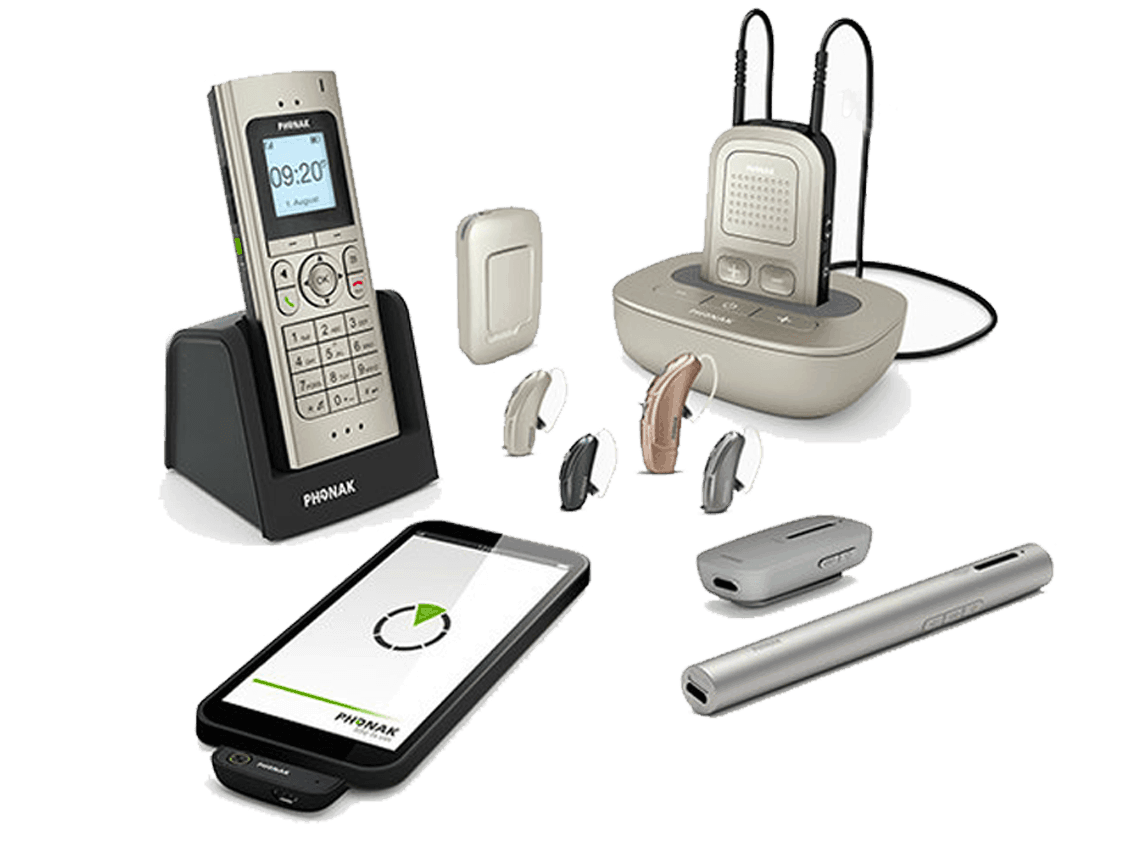Assistive Listening Devices (ALDs)
What are Assistive Listening Devices?
Hearing aids alone are sometimes not the complete answer for people with hearing loss. Assistive listening devices (ALDs) may enable you to clear additional hurdles you encounter daily and add to the benefit your hearing aids can provide. ALDs are other options to help you while using the telephone, watching television, attending meetings or religious services, and conversing in difficult listening situations such as restaurants or automobiles. In addition, alerting devices which include smoke detectors, doorbell signaling devices, alarm clocks, and baby crying indicators, etc., are also available.
FM systems work to enhance hearing in difficult listening environments such as in background noise or listening at a distance, and their portability makes them especially effective for those whose speech understanding ability even in optimal environments is compromised. Common uses include car trips, meetings, restaurants, religious services, and in the classroom. New Bluetooth enabled FM systems are also excellent for cell phone use.

The newest hearing aids provide wireless communication, transforming them into personal wireless headsets. Phone conversations, TV, music, computer, cell phone chats, podcasts, live performances, presentations and more can be streamed to hearing instruments with ease using Bluetooth technology. Click here to obtain more information about hearing instruments with this type of technology.
Facts on Assistive Listening Devices (ALDs)
- ALDs are “binoculars for the ears” and may benefit many people with residual hearing. They are intended to augment standard public address and audio systems by providing signals that can be received directly by persons with special receivers or their own hearing aids.
- A minority of hearing aid owners concurrently use ALDs. About 1 in 4 consumers use a phone amplifier, while less than 10% of hearing instrument owners are users of ALD devices for enhancing their hearing with TV, at movies, in places of worship, or in conferring.
- ALDs “stretch” the performance of a hearing aid by increasing the signal to noise ratio (SNR). This is significant as SNR has to be higher for many people with hearing loss for them to hear speech over background noise.
- ALDs reduce the effect of distance between the person with hearing loss and the sound source; override poor acoustics; and minimize background noise.
- There are hard-wired ALDs and types of wireless ALDs (audioloop, FM, and Infrared, Bluetooth). Most can be used with or without hearing aids, and can be used with an array of receiver attachments for consumers with varying needs and preferences. This includes neck loops, silhouette inductors, headphones, direct audio input and other linkages. Hard-wired ALDs include hand-held amplifiers with microphones, direct audio input microphones, and hard-wired systems.
- Another category of assistive listening devices are the self-contained beam-forming microphone arrays. Some may connect with hearing devices via the telecoil or direct audio input.
- Each type of ALD has advantages and disadvantages. The type of ALD appropriate for a particular application depends on the characteristics of the setting, the nature of the program, and the intended audience.
- ALDs may be installed in large areas, portable for personal use, or in the case of FM systems, built into a hearing aid.
- ALDs are an example of auxiliary aids and services and reasonable accommodations required by the Americans with Disabilities act (ADA ) to be provided by public facilities, state and local governments, and employers, to enable people with hearing loss to participate in their programs and services.
- ALDs typically have not been covered by any public or private health insurance plans, and are not available in mainstream retail outlets. Most ALDs must be purchased through catalogs of ALD distributors or from some hearing health professionals. Access, availability and therefore awareness of ALDs by consumers are limiting factors to their acceptance and use.
- Other assistive technology that can benefit people with hearing loss include alerting devices, such as special smoke detectors, doorbells, telephone ring signalers, telephones, and alarm clocks. These may produce loud signals, visual signals, or tactile signals. Captioning and CART (Computer Assisted Real-time Transcription) also provide great benefit.
- The Florida Relay Telecommunications Relay Inc.(FTRI) is a statewide non- profit organization that administers a Specialized Telecommunications Equipment Distribution Program for citizens of Florida who are Deaf, Hard of Hearing, Deaf/Blind and Speech Disabled. Your Florida Medical Clinic Orlando Health Audiologist can certify an application for you after your hearing test if hearing loss is diagnosed in order for you to obtain a free amplified telephone and ringer through this state funded service. Click here to download an application.
